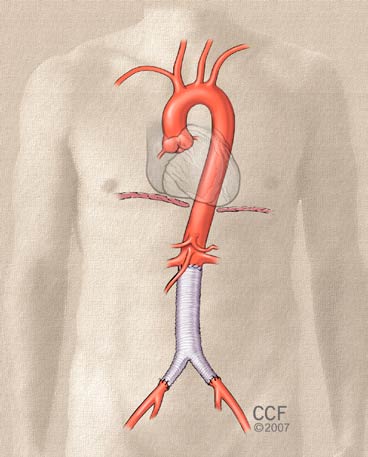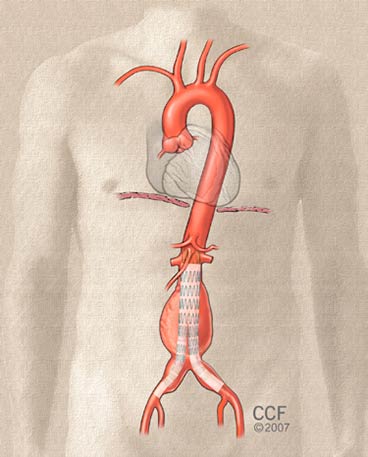
What is an abdominal aortic aneurysm?
The aorta is the largest artery in your body. It carries blood from your heart and branches off to carry blood to the rest of your body. An abdominal aortic aneurysm (AAA) is a weak, bulging area in the lower part of the aorta, usually just below the kidneys. The bulge is like a balloon that can burst if it gets too big.
What causes an abdominal aortic aneurysm?
There are several factors that can cause an AAA:
- Age (older than 65 years) — four times more common among men.
- Smoking.
- Family history of aortic aneurysm.
- High blood pressure.
- Connective tissue disorders (Marfan syndrome, Loeys-Dietz syndrome or Familial Thoracic Aneurysm disease).
- Atherosclerosis (build-up of plaque in your arteries).
What are the symptoms of an abdominal aortic aneurysm?
Because an AAA develops slowly, you may have one for years and not know it. Many times, there are no symptoms until it ruptures. Symptoms of an AAA rupture include:
- Pain in the abdomen (often sharp and sudden).
- Pain in the back.
- Pain in the side.
- Nausea and vomiting.
- Fainting.
- Shock.
If you have an AAA that ruptures, you must get emergency treatment. Without treatment, you will likely die.
How is an abdominal aortic aneurysm diagnosed?
Many times, an AAA is found during tests for other health issues. Because they often do not cause symptoms, it is important to be screened for an AAA. If an AAA is found early, your doctor can keep track of it and help you avoid problems it can cause. Ask your doctor to check for signs of an AAA. He or she will examine you and check for a pulsing feeling in your upper abdomen.
Imaging tests can show how big the AAA is and where it is located. Common tests are:
- Abdominal ultrasound - uses high-frequency sound waves to create pictures and videos of your aorta.
- Computed tomography angiography (CTA) scan - uses dye delivered through an IV to find out the size and location of the AAA.
- Magnetic resonance imaging (MRI) 3 - uses a large magnet, radio waves, and a computer to create pictures of the inside of your body.
Information from these tests can help your doctor create your plan of care.
Who should be screened for an abdominal aortic aneurysm?
Cleveland Clinic, along with several national health associations, recommend screenings for people who are at risk of developing an AAA. Ask your doctor if you should be screened. Check with your insurance provider about coverage for the cost of a screening before you schedule your appointment. Cleveland Clinic recommends an ultrasound screening if you smoke/have smoked and are older than 65 or if you are older than 50 and have a family history of an AAA.
What treatments are available for patients with an abdominal aortic aneurysm?
The only treatment for an AAA is surgery. In general, surgery is not recommended until the AAA is 5.0 cm for women and 5.5 cm for men. Surgery for smaller AAAs is not recommended because the benefits usually do not outweigh the risks.
Your vascular surgeon will closely follow you to check the size of the AAA and talk to you about surgery when it is big enough. If you have an AAA and keep other health conditions well-controlled, your AAA may not grow quickly. At Cleveland Clinic, your care will include a cardiologist and vascular medicine doctors and surgeons who will work together to create the best plan of care possible.
There are two types of surgical treatment for patients with an AAA – open/traditional repair and endovascular repair. Both types of repair have advantages and disadvantages. Your vascular surgeon will talk to you about the type of repair that is best for you and your individual risks and benefits of each procedure.

Open (traditional) repair is done through an incision in your abdomen. The aorta is clamped above and below the aneurysm to stop the flow of blood. The area of the aneurysm is replaced with a synthetic graft. The average hospital stay after an open procedure is 5 to 10 days. Most people can return to their normal activities within 3 months. Some possible complications include bleeding, infection, heart attack, and intestinal or leg blood flow issues. This procedure results in excellent long-term durability. Follow-up visits are every 3 to 5 years.

Endovascular repair (EVAR) is a minimally invasive procedure done through small incisions in your groin. The surgeon uses a long, thin tube called a catheter to guide a small fabric device attached to metal stents (stent graft) through the arteries to your aorta. The stent graft is opened in the area of the AAA to reinforce the aorta and create a new path for blood to flow through the aorta. The average hospital stay after an EVAR procedure is 1 day. Most people can return to their normal activities in 2 weeks. The types of complications possible with EVAR are the same as those possible with open repair, but the rate of complications is lower with EVAR. Because of this, EVAR is the preferred choice for aneurysm repair, especially for high-risk patients. Some complications include bleeding, infection, and damage to blood vessels. While EVAR offers the benefits of a shorter hospital stay and smaller incisions, this type of repair may not last as long as open repair. There are durability concerns of the repair after 10 years, and about 20% of patients need additional procedures to keep the repaired area sealed. Follow-up visits are at least once per year.
What can I do to prevent an abdominal aortic aneurysm?
You cannot control AAA risk factors like age, connective tissue disease and a family history of aneurysms. But, you can reduce your risk of an AAA by living a heart-healthy lifestyle and managing other problems, such as high blood pressure and heart, lung or kidney disease. Ask your vascular surgeon for information about a healthy diet, exercise plan, quitting smoking and other ways you can help reduce your risk of an AAA or slow down the growth of one you have.
How does an abdominal aortic aneurysm affect my life?
It is important to keep all follow-up visits and have all tests your vascular surgeon orders. They help your vascular surgeon keep track of the size of your AAA and make any needed changes to your plan of care. Without follow-up, your AAA can become large and burst, which can be deadly. Follow-up and testing greatly reduce the risk of your AAA rupturing and increase your ability to have surgery to repair the AAA when needed.
Sometimes patients with an AAA have aneurysms in other parts of their bodies. Cleveland Clinic’s team of vascular surgeons, vascular medicine physicians, and cardiologists will work together to assess your risk and, if needed, order tests to check for other aneurysms.